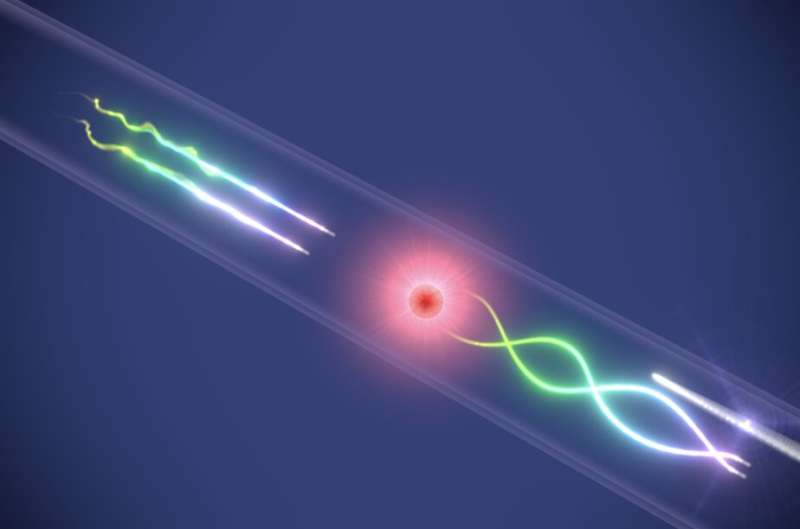October 6, 2022 feature
A new method to enable efficient interactions between photons

Photons, particles that represent a quantum of light, have shown great potential for the development of new quantum technologies. More specifically, physicists have been exploring the possibility of creating photonic qubits (quantum units of information) that can be transmitted over long distances using photons.
Despite some promising results, several obstacles still need to be overcome before photonic qubits can be successfully implemented on a large-scale. For instance, photons are known to be susceptible to propagation loss (i.e., a loss of energy, radiation, or signals as it travels from one point to another) and do not interact with one another.
Researchers at University of Copenhagen in Denmark, Instituto de Física Fundamental IFF-CSIC in Spain, and Ruhr-Universität Bochum in Germany have recently devised a strategy that could help to overcome one of these challenges, namely the lack of photon-photon interactions. Their method, presented in a paper published in Nature Physics, could eventually aid the development of more sophisticated quantum devices.
"We have been working on the deterministic interfacing of single quantum emitters (quantum dots) to single photons for over 15 years and have developed a very powerful method based on nanophotonic waveguides," Peter Lodahl, one of the researchers who carried out the study, told Phys.org. "We generally applied these devices for deterministic single-photon sources and multi-photon entanglement sources, but another possible application would be to induce nonlinear operations on photons."
Lodahl and his colleagues realized the first proof-of-concept demonstration of nonlinear operations using individual photons back in 2015. When they investigated this effect further, however, they encountered difficulties in thoroughly understanding the fundamental physics underlying this complex, single-photon and nonlinear interaction.
"In our previous work, we found that the physics governing the nonlinear interaction of pulses of light was remarkably rich and gave rise to some novel opportunities for constructing photonic quantum gates and photon sorters," Lodahl said. "We have carried out the first experimental study of nonlinear quantum pulses undergoing nonlinear interaction due to the coupling with a deterministically coupled quantum emitter."
In their new experiment, the researchers used the efficient and coherent coupling of a single quantum emitter with a nanophotonic waveguide to enable nonlinear quantum interactions between single-photon wave packets. To do this, they used a single quantum dot, a nm-sized particle that behaves like a two-level atom, which was embedded in a photonic crystal waveguide.
"In such systems, the coupling is deterministic, so that even one photon launched into the waveguide is interacting with the quantum dot," Lodahl explained. "Sending in pulses containing two or more photons induce quantum correlations since only one photon at a time can interact with the quantum dot. By controlling the duration of the quantum pulse, we can tailor these correlations, and the interaction between the photons."
Using their experimental method, Lodahl and his colleagues were essentially able to control a photon using a second photon, which was mediated by their quantum emitter. In other words, they successfully realized a nonlinear photon-photon interaction.
"We developed a method to get photons to efficiently interact with each other mediated by the coupling to quantum dots," Lodahl said. "We think this could open new directions for making photon-photon quantum gates (which is the difficult gate in photonic quantum computing) or deterministic photon sorter devices that are essential, e.g., for quantum repeaters."
The new strategy introduced by this team of researchers could have important implications for both quantum physics research and the development of quantum technology. For instance, their method could open new possibilities for the development of quantum optical devices, while also allowing physicists to experiment with tailored complex photonic quantum states.
"We have a range of activities that extend the present work," Hanna Le Jeannic, another researcher involved in the study, told Phys.org. "On a fundamental level, we are looking at understanding more deeply how quantum states of light are affected by traveling through a single quantum dot. But we are also already foreseeing applications of this quantum interaction."
At the moment, Lodahl, Le Jeannic and their colleagues are trying to exploit the nonlinear photon-photon interaction realized in their recent study to simulate the vibrational dynamics of molecules. This could be achieved by mapping the vibrational dynamics of complex molecules onto the propagation of photons in advanced photonic circuits.
More information: Hanna Le Jeannic et al, Dynamical photon–photon interaction mediated by a quantum emitter, Nature Physics (2022). DOI: 10.1038/s41567-022-01720-x
Ravitej Uppu et al, Quantum-dot-based deterministic photon–emitter interfaces for scalable photonic quantum technology, Nature Nanotechnology (2021). DOI: 10.1038/s41565-021-00965-6
A. Javadi et al, Single-photon non-linear optics with a quantum dot in a waveguide, Nature Communications (2015). DOI: 10.1038/ncomms9655
Journal information: Nature Nanotechnology , Nature Communications , Nature Physics
© 2022 Science X Network




















